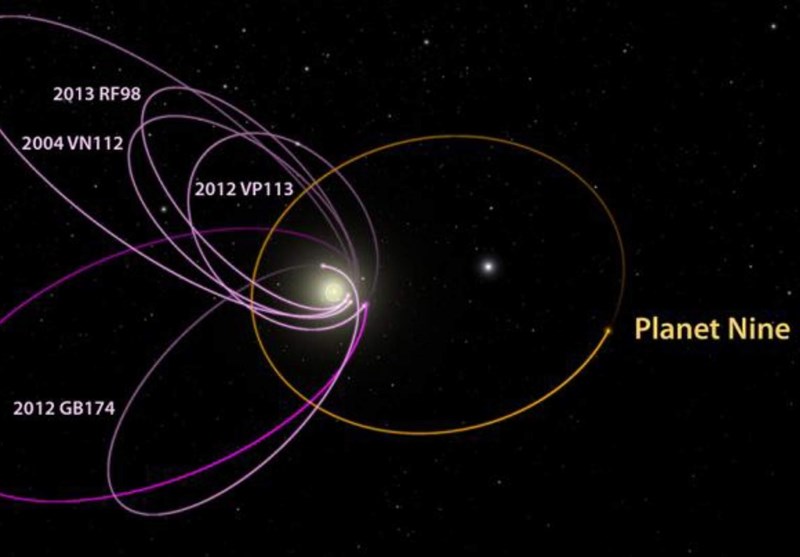New Dwarf Planet Discovered in Outer Reaches of Solar System
TEHRAN (Tasnim) – About 8.5 billion miles away from the center of the solar system, a small dwarf planet orbits our sun.
Unknown and undetected for millennia, this planetary body, known as 2014 UZ224, is among the most distant objects in our solar system, more than twice as far from our sun as Pluto.
The discovery of the dwarf planet by a team of Michigan scientists adds to a growing number of newly-discovered objects at the edge of our solar system. The techniques they employed could go a long way in discovering other objects lurking in the night sky, including the elusive and headline-making "Planet Nine," if it exists.
The team was led by David Gerdes, a physics professor at the University of Michigan. Over the summer, Professor Gerdes gave undergraduates visiting over the summer a challenge: Spot objects in our solar system hiding in maps of our galaxy. The students had to figure out a way to spot relatively nearby objects moving in intermittent photographs of the Milky Way.
"We often just have a single observation of the thing, on one night," Gerdes told NPR. "And then two weeks later one observation, and then five nights later another observation, and four months later another observation."
Because distant stars and galaxies remain relatively stationary from our point of view on Earth, only close objects, within our own solar system, would appear to move between the images. Using software developed by the team, the students detected 2014 UZ224 moving slightly, while the more distant objects appeared still.
The dwarf planet was hard to spot. It's small, even for a dwarf planet: only 330 miles across, and so far out that it takes roughly 1,100 Earth years to make a full orbit around the sun. The last time UZ224 was in its current position, "Good King" Wenceslas I, now known for his appearance in the famous Christmas carol, was alive and well, acting as the Duke of Bohemia.
For comparison, Pluto, the largest dwarf planet, is 1,475 miles (2,374 kilometers) in diameter and takes 248 Earth years to complete one orbit around the sun.
The Michigan team says that 2014 UZ224 is a dwarf planet, according to the standards set down by the International Astronomical Union (IAU):
A "dwarf planet" is a celestial body that (a) is in orbit around the Sun, (b) has sufficient mass for its self-gravity to overcome rigid body forces so that it assumes a hydrostatic equilibrium (nearly round) shape, (c) has not cleared the neighborhood around its orbit, and (d) is not a satellite.
While Gerdes's team is confident in calling UZ224 a dwarf planet, Gerdes admits that some astronomers might argue that it is too small to qualify.
"2014 UZ 224 is the third-furthest known object of significant size from the Sun while still a member of the Solar System," says Manfred Cuntz, an astrophysicist at University of Texas at Arlington, in an interview with The Christian Science Monitor. "Understanding objects beyond planet Neptune, thus located at the outskirts of the Solar System, provides important clues about the origin and formation process of the solar system, including processes taking place thereafter."
The IAU currently recognizes five dwarf planets: Pluto, Ceres, Eris, Haumea, and Makemake. Except for Ceres, which is in the asteroid belt, these are Kuiper Belt Objects, from the outer reaches of the solar system. Dozens more objects that could be dwarf planets have not yet been confirmed.
By far, the most controversial dwarf planet is Pluto, which was discovered in 1930 and identified as a full planet for decades.
"By 2006, the international astronomical community was at a crossroads regarding Pluto's status as a planet," thanks in part to more discoveries of similarly-sized objects near Pluto's orbit, and just beyond in the Kuiper Belt, says Megan Pickett, an associate professor of physics at Lawrence University, in an email to the Monitor.
In 2005, when astronomers discovered Eris – similar in size to Pluto – they faced a choice, she explains: "cataloging a Solar System with dozens, if not hundreds of 'planets,' or revising the definition of planets (an idea that had been suggested as early as 1991)."
The IAU chose to revise the definition of planets, officially booting Pluto into the new category of "dwarf planets."
The discovery of 2014 UZ224 comes as astronomers are looking for the hypothesized "Planet Nine." Astronomers have speculated about another massive planet for decades. In fact, when Clyde Tombaugh discovered Pluto in 1930, he was looking for a planet large enough to disturb the orbit of Neptune, not a tiny chunk of icy rock.
Researchers calculated in 2014 that a number of oddities in the orbits of far-out objects could be explained by a distant and unknown planet anywhere from 2 to 15 times more massive than Earth, and the hunt was on.
While Planet Nine continues to elude observers, more and more small objects like UZ224 are being analyzed for clues to Nine's exact location. Gerdes hopes that his team, using the same techniques that led them to discover this dwarf planet, might find Planet Nine.
In fact, he says, his galaxy maps might already contain a picture of the mysterious world. "I'm excited about the chances of the people in this room finding it," Gerdes said. "Of course I'm happy for humanity if someone else finds it, it would be the most exciting astronomical discovery in our lifetime, I think."





